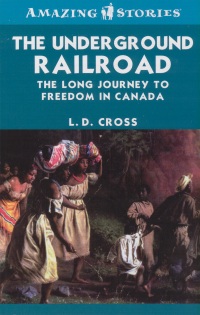| ________________
CM . . . . Volume XVII Number 29 . . . . April 1, 2011
excerpt:
The Underground Railroad is a history of how escaped slaves in the southern United States made their way to Canada. The Underground Railroad was not a railroad at all, of course, but a series of routes by which the escapees could expect to find compassionate people who would help them with accommodation and shelter from those trying to catch them and provide food and transportation through the states to Canada. The book is also a history of the treatment the ex slaves received upon their arrival in Canada, much of it hostile and openly racist. There are many interesting stories about abolitionists in The Underground Railroad that make the book entertaining and should make it popular with young readers. It could be used for classroom support, providing, as it does, great potential for classroom discussion. Innovative teachers will find numerous ways in which to use the book to stimulate student interest. Students should be appalled at the way slaves were often treated and surprised at the bigotry that was widespread in Canada even up until the twentieth century. The Underground Railroad is well researched [See note 1] and includes meaningful detail that makes the story come to life. One example is the account of Marie Joseph Angelique who was hanged [See note 2] for arson in Montreal in 1734. She had set fire to her owner's house, hoping she could escape during the ensuing confusion but, instead of her burning just one house, 46 caught on fire, and Marie Joseph Angelique was captured, tried and executed. Mention is made of wages paid to black labourers in Canada in the middle of the 19th century. It would be interesting to know what a wage of 50 cents a day in 1849 is worth today. As a result of the time value of money, it may be the equivalent of wages in the 21st century. The Underground Railroad has 10 chapters of varying length, from five to seventeen pages. It has an index and bibliography of helpful books and 12 black and white illustrations spread throughout the book. In addition, it has a Prologue with a fictional account of how one slave escaped in a wooden box and an Epilogue which deals with the prejudice a real black woman born in Canada faced in the twentieth century. There is also a useful North America Slavery Timeline from the sixteenth to the twentieth century. Author, L. D. Cross has written many magazine articles. She has also written three other titles for the series, "Amazing Stories," including Spies in Our Midst: The Incredible Story of Igor Gouzenko, Cold War Spy. In addition, she has co authored other titles, including Marriage is a Business! Recommended. Thomas F. Chambers, a retired college teacher, lives in North Bay, ON.
Note 1. One minor error concerns the Rebellions of 1837 in Upper and Lower Canada. The Family Compact was, as Cross states, in control in Upper Canada, but political control in Lower Canada was in the hands of the Chateau Clique.
To comment
on this title or this review, send mail to cm@umanitoba.ca.
Copyright © the Manitoba Library Association. Reproduction for personal
use is permitted only if this copyright notice is maintained. Any
other reproduction is prohibited without permission.
NEXT REVIEW |
TABLE OF CONTENTS FOR THIS ISSUE
- April 1, 2011.
AUTHORS |
TITLES |
MEDIA REVIEWS |
PROFILES |
BACK ISSUES |
SEARCH |
CMARCHIVE |
HOME |
